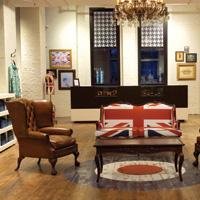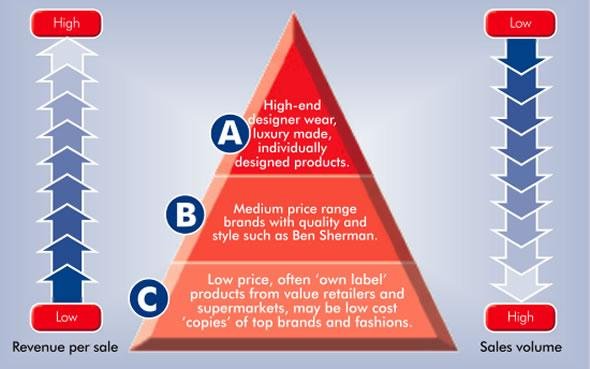Ben Sherman is a globally recognised lifestyle brand. It has grown from its business beginnings in quality shirts in Brighton in 1963 and is now sold in 35 countries around the world. It has expanded into the USA, Europe, and Australasia.
In 2004, Ben Sherman was acquired by the American-based company, Oxford Industries. This group is an international apparel design, sourcing and marketing company that features a diverse portfolio of owned and licensed lifestyle brands.

Ben Sherman’s name has always been closely linked with the British music scene and with fashion. Its customers are young and at the forefront of style.
Throughout the years high profile customers include musicians, models, actors and bands, such as Blur, Oasis and the Kaiser Chiefs. The growth of the brand can be traced through changes in musical taste and this is a key part of Ben Sherman’s marketing strategy.
As a young person reading this, you are a central market segment of Ben Sherman’s target market. A market segment is a group of people with similar needs or characteristics, such as age, gender or lifestyle. For example, you like music, you like fashion and you are willing to spend money on top brands that deliver the quality and image that you want.
As the company founder Ben Sherman said in 1963: ‘Looking good isn’t important, it’s everything.’
Ben Sherman has developed a balanced marketing mix. This is often referred to as the 4 P”s – product, price, promotion and place. By getting the mix right, the company ensures that its products reach the market segments it is aiming the brand at. This approach helps the business remain competitive and extends its market share and influence.
The marketing mix is like a cake recipe. Most cakes need the basic ingredients of eggs, flour, sugar and milk. However, a child”s birthday cake will require a different recipe from a wedding cake. The key is to combine the ingredients to get the right cake for the right occasion. The marketing mix works in exactly the same way.
The key ingredients of product, price, promotion and place are all necessary for the appropriate marketing of the product. Ben Sherman chooses the right combination of each element to satisfy different customers’ needs.
Product

Ben Sherman has to decide whether to:
- create a product and then market it to target customers (product-orientated) or
- find out what the market wants and then provide it (market-orientated)
To achieve both, the company produces a wide product range that appeals to all its target market segments. The range includes casual clothes, formal wear, denim, footwear and lifestyle accessories, such as underwear, watches, bags, belts and fragrances.
A strong brand image ties the product range together. Each collection has an umbrella theme. In 2007, the product theme was ‘This Sporting Life’ and the marketing theme was ‘British music and style’.
Product life cycle

Ben Sherman uses major fashion shows to launch its collections to the press. The fashion year has two cycles the spring/summer season and the autumn/winter one. The fashion industry is highly competitive and fast-moving. Fashion products tend to have a short life cycle.
This means the time between the launch of a product and the point at which that product is ‘mature’ is very quick. Competition amongst fashion retailers forces businesses to refresh their ranges a number of times in a year. This topping-up modifies the product as it reaches the maturity stage. The boost of a new product or style then extends the life of the range.
Products need refreshing to avoid a dip in sales during the Saturation stage of the life cycle which could result in an early decline. The additions and changes help sales rise again, earning extra sales revenue and profit, as well as maintaining the Ben Sherman brand in the market.
Price

Ben Sherman has to assess which markets its products are aimed at and set a price to match. There are a number of pricing strategies that a business can use for its products including:
- cost based pricing where the selling price is set to cover the cost of manufacture.
- market orientated pricing.
Market orientated pricing covers several different approaches:
- market penetration, where a new product is priced low to attract a high volume of sales
- market skimming where a new product has premium pricing to give high revenues whilst the product is unique in the market
- premium pricing, where there is a uniqueness and exclusiveness about the product so that it can command a high price
- economy pricing, which tends to be for no-frills, basic products, where the cost of manufacture and marketing are kept to a minimum.

The price of a product relates to its perceived value. Lower priced items will expect a higher volume of sales, whilst fewer sales of luxury products may achieve the same revenue through higher pricing.

A ‘product map’ shows where products are positioned in the market. Each product type behaves in a different way. Customers are willing to pay more for ‘aspirational’ products, such as designer wear. These products or brands show that those who own or wear them have a degree of success in their lives. These brands are not price sensitive, as people are willing to pay premium prices for individuality or for the latest styles.
Low price brands often copy the market leaders and may be generic own brands, such as those produced by supermarket chains. The main purpose of the price here is to indicate value for money and such brands do not expect customers to show loyalty.

Ben Sherman produces mostly medium-price range products. Its position in the market for clothing is shown on the product map diagram. The mix of product and price is clearly evident here. These brands are identifiable by their quality and style.
Ben Sherman uses brand identity images like the plectrum logo and the Ben Sherman script label in subtle ways. Its products are good quality and individually styled and therefore the price reflects this. There is a relationship between product quality and price (revenue per sale). The pricing also impacts the level of sales. Ben Sherman’s pricing best matches aspect B.
Place
This refers both to the places where Ben Sherman products may be bought and to the channels of distribution used to deliver the products to these places.
Place is not always a physical building such as a retail outlet or shop, but includes any means by which the product is made available to the customer. A business has to balance getting enough of its products to its target customers against the problems or costs of distributing them.

For a premium or luxury brand, making the products too easily available might reduce the perceived value of the brand. This illustrates the need to select carefully how the marketing mix is put together to match the product to the needs of the target market.
Ben Sherman limits where its products are sold and keeps a tight rein on how they are sold and its distribution channels. This creates a unique Ben Sherman experience wherever customers buy its products.
Distribution channels
Ben Sherman uses three traditional distribution channels. Each has distinct characteristics and different strengths and weaknesses:
- its own stores – where the brand is strongest but requires investment in property, stock and salespeople
- independent fashion stores – whilst offering a unique or more specialised sales channel these outlets carry limited amounts of stock. Also, the costs of processing, e.g. for delivery and administration, are relatively higher for smaller orders.
- department stores – will buy centrally but may want discounts if they order in bulk, reducing Ben Sherman’s profitability
Ben Sherman works in close partnership with department stores, creating ‘shop-in-shops’ a unique concept where the customer feels that they are in a Ben Sherman store.
The store shares its marketing information about what types of customers are purchasing and which products are most in demand. This enables Ben Sherman and the department store to provide the relevant stock to maximise revenue.
Ben Sherman also has its own stores around the world and opens new ones each year. It has a long-term commitment to expanding globally. Although the stores represent a big investment, they are important to the company in controlling its own sales environment and increasing profit. The interiors of its flagship stores reflect British style and identity through use of antique furniture, music memorabilia, photographs and the Union Jack flag.
For a limited time in 2007, each store worldwide displayed a specially designed Gibson guitar in a dedicated window space decorated with and inspired by the Ben Sherman product, brand and music influences. Gibson is the world’s leading guitar specialist and created for Ben Sherman a set of 20 collectable limited edition guitars. Each unique guitar was then sold at auction online to raise money for charity.
Ben Sherman used the guitar auction online to link the physical worldwide stores to the Internet. The company transmitted news of the auctions and bids via the Internet and gained online, national and regional press.

Ben Sherman also uses newer channels of distribution. It relaunched its website www.bensherman.com in February 2007 to provide a more interactive experience for customers to encourage them to spend more time on the site and shop:
- The site provides an online ordering service.
- It offers news updates for customers on the latest Ben Sherman products.
- The website helps to create an online ‘community’ of people who like Ben Sherman products.
- It gives relevant context for Ben Sherman products by providing video and music links, for example, the top 10 records of the 1970s.
This helps to build the brand philosophy and values. The company sees its online services as particularly important in reaching customers now and in the future.
Promotion

The purpose of promotion is to obtain and retain customers. It covers:
- ‘above-the-line’, which is using independent media to reach a wide audience easily, but over which the company may have limited control, for example, magazine advertising. This reaches a mass audience but can be hard to measure its impact.
- ‘below-the-line’, which uses media over which the business has control, for example, direct mailing. This type of promotion can be more cost-effective and give more measurable response rates.
Ben Sherman uses both above-the-line and below-the-line promotions to help inform customers about its products. Through this information, it increases the customers’ desire to buy its products.
Promotional activities
Some people think of promotion as being just advertising but advertising is only one aspect. Promotion may also include:
- direct mail – for example, catalogues, newsletters you may receive by post or email
- exhibitions or events – Ben Sherman has a high profile at fashion events and music events, for example, sponsoring a series of live gigs to support new British music in collaboration with Gibson guitars and music channel MTV
- sales promotions – such as discounts, money-off coupons or competitions
- public relations – perhaps through press conferences or by participating in charitable events, such as the Gibson Guitar auction for Nordoff Robbins charity
- sponsorship – Ben Sherman sponsored the ‘Best Breakthrough Artist’ category at the 2007 Q Awards
- product placement – Ben Sherman gives clothes to famous people so that they create publicity when they wear them. This is seen as an endorsement of the product. Amy Winehouse and Ricki from the Kaiser Chiefs have been used to promote Ben Sherman products by wearing them at high profile events and featuring them in the printed press
- branding – you can see the Ben Sherman brand in the layout and decoration of its stores, its links to music, its advertising campaigns, packaging and point-of-sales displays
Conclusion

Ben Sherman is a brand that appeals to the youth market. Its responsiveness to changing tastes in fashion and music throughout the last fifty years has provided it with a unique heritage of quality, personality and style. This has made Ben Sherman into a great British icon, reflecting British culture as it does business across the world.
Whilst each element of the marketing mix is important in its own right, the right balance of the four elements is critical. A business must clearly understand its target market – the customers at which it is aiming its product range – to ensure that it has the marketing mix balanced to appeal to this market.
Ben Sherman’s continuing global growth and high profile in music and fashion demonstrates that, as far as the marketing mix is concerned, it has got the balance right.
